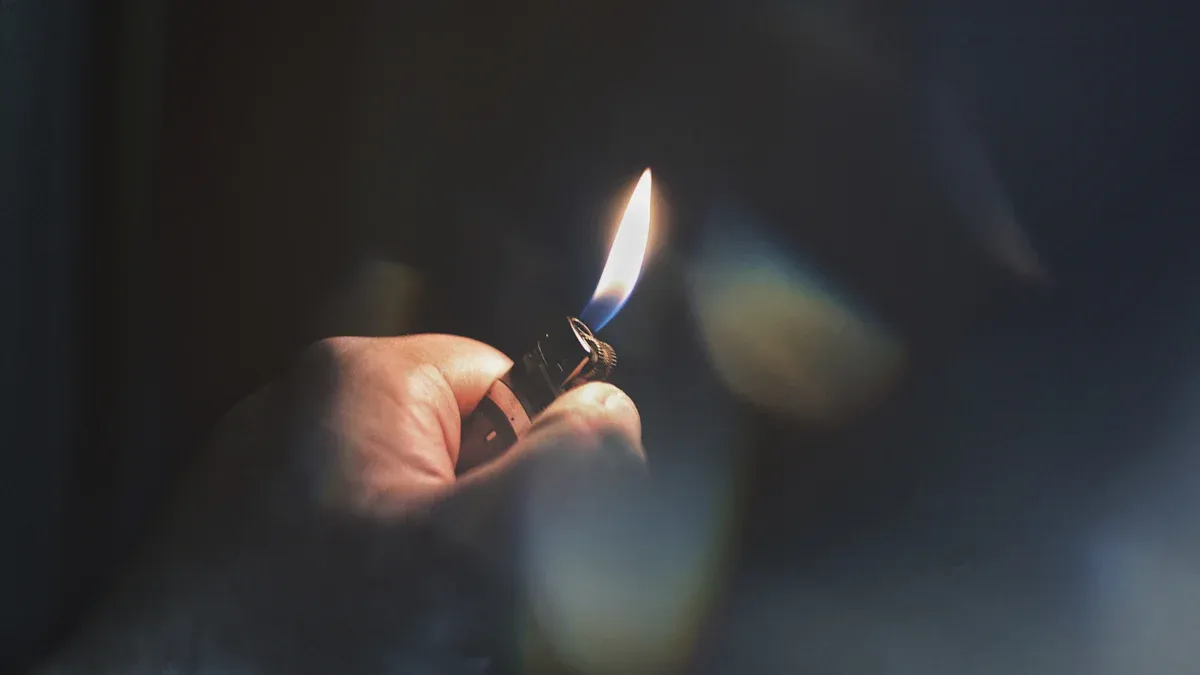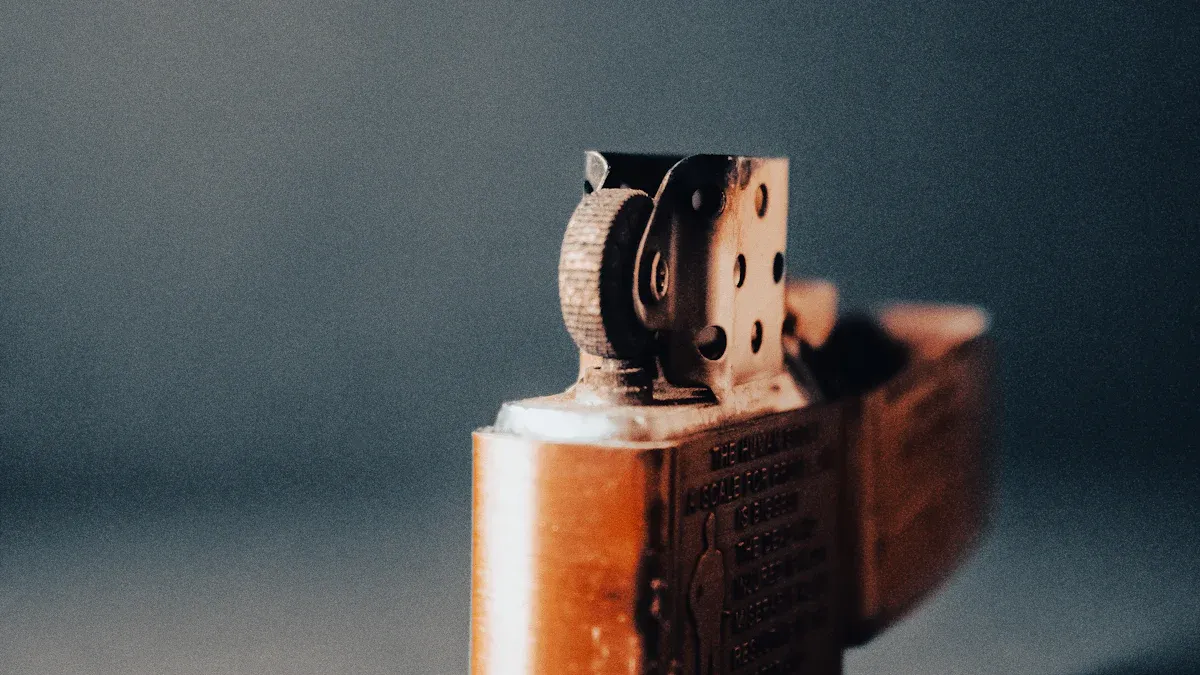
Lighters play a vital role in your daily life. They provide a quick and reliable way to start a fire, whether for lighting candles, cooking, or outdoor adventures. These tools also reflect human progress. Each lighter type tells a story of innovation, showing how technology has evolved to meet your needs.
Key Takeaways
- Lighters changed from big chemical gadgets to small, handy tools. This shows how humans improved fire-starting technology over time.
- Electric and plasma lighters are better for the environment. They cut down waste and are easy to use with rechargeable batteries.
- Famous designs like Zippo lighters stand for strength and importance in culture. They are not just tools but also part of history.
Early Innovations in Lighter Types

Döbereiner’s Lamp: The First Chemical Lighter
The journey of the lighter type began in 1823 with Döbereiner’s Lamp. Johann Wolfgang Döbereiner, a German chemist, invented this device. It used a chemical reaction between hydrogen gas and platinum to produce a flame. You might find it fascinating that this early lighter was bulky and required careful handling. It wasn’t portable, but it marked a significant step forward in fire-starting technology. Döbereiner’s Lamp demonstrated how chemistry could create a controlled flame, paving the way for future innovations.
Friction Matches and Their Role in Fire-Starting
Before modern lighters, friction matches revolutionized fire-starting. Invented in the early 19th century, these matches used a chemical-coated tip that ignited when struck against a rough surface. You could carry them easily, making them a practical tool for everyday use. Friction matches became popular because they were simple and effective. They also inspired the development of portable fire tools, bridging the gap between traditional methods and modern lighter types.
Mechanical Lighters: The Transition to Portable Fire Tools
Mechanical lighters emerged in the late 19th century as a more convenient alternative to matches. These devices used a flint and wheel mechanism to create sparks, igniting a fuel source. You might recognize this design in some lighters today. Mechanical lighters were compact and reusable, making them a practical choice for many. They represented a shift toward portable and reliable fire-starting tools, setting the stage for the iconic lighter types that followed.
The Rise of Iconic Lighter Types
Ferrocerium and Its Impact on Lighter Design
Ferrocerium, invented in 1903 by Carl Auer von Welsbach, transformed how lighters worked. This synthetic material produces sparks when struck, making it a key component in many lighter types. You might recognize it as the “flint” in modern lighters. Its ability to create consistent sparks revolutionized fire-starting tools. Ferrocerium made lighters more reliable and easier to use. Unlike earlier methods, it required less effort and worked in various conditions. This innovation laid the foundation for the portable and efficient designs you see today.
Zippo Lighters: Durability and Cultural Icon
Zippo lighters, introduced in 1933, became a symbol of durability and style. Their windproof design ensured a steady flame, even in harsh weather. You could refill them with fuel, making them reusable and long-lasting. Over time, Zippos gained cultural significance. Soldiers carried them during wars, and they appeared in movies and music. Collectors value their unique designs and craftsmanship. A Zippo lighter type is more than a tool; it’s a piece of history that reflects innovation and resilience.
Disposable Lighters: Affordable and Accessible Fire-Starting
Disposable lighters emerged in the 1970s, offering a cheap and convenient way to start a fire. These lighters use butane fuel and a simple ignition mechanism. You can find them almost anywhere, from gas stations to grocery stores. Their affordability and ease of use make them a popular choice for everyday tasks. However, they are single-use items, contributing to environmental concerns. Despite this, disposable lighters remain one of the most widely used lighter types due to their accessibility and practicality.
Modern Lighter Types and Future Innovations
Butane Lighters: Precision and Efficiency
Butane lighters have become one of the most popular tools for fire-starting. These lighters use butane gas as fuel, which burns cleanly and efficiently. You’ll notice their precision when lighting candles, stoves, or even cigars. The adjustable flame control allows you to customize the flame size based on your needs. This feature makes them versatile for both indoor and outdoor use. Butane lighters are also refillable, which means you can use them multiple times, reducing waste. Their reliability and ease of use make them a preferred lighter type for many.
Electric Lighters: Sustainability and Convenience
Electric lighters offer a modern and eco-friendly alternative to traditional designs. Instead of using gas or fuel, they rely on rechargeable batteries to create a spark. You can charge them using a USB cable, making them convenient for everyday use. These lighters are flameless, which means they are safer to use in windy conditions. They also eliminate the need for disposable lighters, helping reduce environmental waste. If you’re looking for a sustainable option, electric lighters are an excellent choice.
Tip: Keep your electric lighter charged to ensure it’s always ready when you need it.
Plasma Lighters: The Future of Fire-Starting Technology
Plasma lighters represent the cutting edge of fire-starting tools. They use an electric arc, or plasma, to generate heat. This technology doesn’t rely on traditional fuel sources, making it both innovative and environmentally friendly. Plasma lighters are windproof and work in almost any weather condition. You’ll find them ideal for outdoor adventures or emergency kits. Their sleek and futuristic design also appeals to tech enthusiasts. As lighter technology continues to evolve, plasma lighters showcase what the future holds.
The evolution of lighters highlights human ingenuity. From chemical reactions to electric arcs, each innovation has improved your convenience and safety. Modern designs focus on sustainability, reducing waste and environmental impact.
Looking ahead: Future lighters may integrate smart technology, offering even greater efficiency and eco-friendliness. What advancements do you imagine?
FAQ
What is the most durable lighter type?
Zippo lighters are known for their durability. Their windproof design and refillable feature make them a long-lasting choice for various conditions.
Are electric lighters better for the environment?
Yes, electric lighters are eco-friendly. They use rechargeable batteries instead of disposable fuel, reducing waste and promoting sustainability.
Can plasma lighters work in windy conditions?
Plasma lighters perform well in windy conditions. Their electric arc technology ensures reliable ignition, making them ideal for outdoor use.


